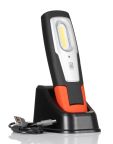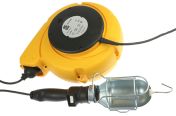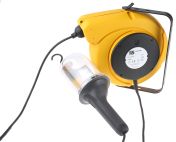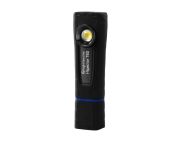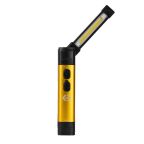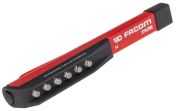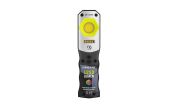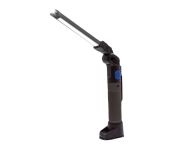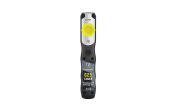- Automation & Control Gear
- Cables & Wires
- Enclosures & Server Racks
- Fuses & Circuit Breakers
- HVAC, Fans & Thermal Management
- Lighting
- Relays & Signal Conditioning
- Switches
- Batteries & Chargers
- Connectors
- Displays & Optoelectronics
- ESD Control, Cleanroom & PCB Prototyping
- Passive Components
- Power Supplies & Transformers
- Raspberry Pi, Arduino, ROCK, STEM Education & Development Tools
- Semiconductors
Inspection Lamps
Inspection lamps and lights are high-quality illumination tools designed to provide precise, focused lighting for the detailed visual examination of instruments, equipment, and workspaces. By delivering exceptional brightness and clarity, they significantly improve accuracy and efficiency in tasks requiring close inspection.
These lamps range from small, battery-operated torches or pen-style lights to larger models with hooks, magnets, or adjustable mounts for secure positioning. Inspection lamps are perfect as work lights for engineers, allowing them to inspect hard-to-reach areas not illuminated by other light sources.
Who Uses Inspection Lamps and Lights?
Multi-purpose inspection lights are used by many professionals that require directable light sources to conduct their work effectively, including:
- Construction workers
- Engineers and electricians
- Plumbers and HVAC technicians
- Manufacturing and assembly personnel
- Healthcare professionals, including hospital staff and dentists
- Automotive garage technicians
- Electronics industry workers and technicians
Their adaptability makes them indispensable across industries involved in carrying out detailed visual work in constrained or low-light environments.
What Are the Types of Inspection Lamps?
Inspection lamps are diverse, offering various power sources and mounting options to suit specific professional needs. Most provide a reliable light source for cramped or hard-to-access areas where cables can't reach.
Here are the common types available:
- LED Inspection Lamps: These lamps provide bright, white light with high energy efficiency and exceptional longevity. They are ideal for clear visibility in detailed work.
- Fluorescent Lamps: Known for their durability and powerful illumination, fluorescent inspection lamps offer a long operational life, making them a reliable choice for consistent lighting for inspections.
- Incandescent and Halogen Lamps: Fitted with halogen and incandescent bulbs, these versatile inspection lamps provide strong illumination and exhibit high resistance to failure.
- Battery-Operated Lamps: Equipped with replaceable batteries, these lamps offer cordless portability for remote or temporary lighting needs.
- Rechargeable Lamps: These lamps feature integrated rechargeable batteries and are powered via USB or DC/AC sources. They eliminate the need for battery replacements.
- Mains-Powered Lamps: These larger options offer continuous, high-intensity illumination without reliance on batteries.
- Hands-Free Lamps: Designed with integrated hooks or magnets, these inspection lights can be secured easily to various surfaces, providing convenient hands-free illumination for intricate tasks.
Key Benefits of Using Inspection Lamps for Precision Tasks
Inspection lamps significantly enhance accuracy and efficiency for detailed work through the following benefits:
- Focused Illumination: These inspection lights allow users to see fine details clearly, enabling accurate work across electronics, medical, and industrial settings.
- Adjustable Brightness: Many inspection lamps feature adjustable brightness levels. This flexibility lets users tailor the light intensity to specific tasks and environmental conditions, reducing eye strain.
- Magnification: Some inspection lights come equipped with integrated magnifying lenses. This feature enables closer examination of intricate components, crucial for highly detailed assembly or repair work.
- Hands-Free Operation: Certain portable inspection lamps are designed for hands-free use, incorporating clips, magnets, or stands. This frees up both hands for precision tasks, improving efficiency and stability.
How to Choose the Right Inspection Lamp for Your Application
Consider the following factors to ensure your inspection lamp matches your needs:
- Type of Work: Different tasks demand varying light characteristics. Consider whether you need broad illumination for general work or a focused beam for precision tasks.
- Brightness and Beam Type: Evaluate the light output and beam pattern. A wide floodlight is good for large areas, while a narrow spotlight suits detailed inspection.
- Power Source: Choose a power option that fits your mobility needs. For example, a battery-operated option gives you cordless convenience while a rechargeable LED inspection lamp removes the need to constantly replace batteries.
- Mounting Options: Assess how you'll position the light. For instance, if you need hands-free overhead illumination, opt for a lamp with integrated hooks or flexible arms.
- Environmental Needs: If you’ll be working in harsh conditions, consider a waterproof work light that can withstand the elements.
Maintenance and Safety Tips for Inspection Lamps
Regular cleaning and maintenance are crucial for preserving the performance and longevity of your inspection lamps. The following best practices can help ensure consistent and reliable illumination when you need it most:
- Wipe lenses and housings regularly with a soft, damp cloth to remove dust and grime.
- Clean electrical contacts periodically to ensure optimal connectivity and prevent flickering.
- Check and replace batteries and bulbs as needed to maintain consistent brightness.
- Store inspection lights in a cool, dry place away from extreme temperatures and moisture.
When using lighting equipment, always take safety precautions to prevent injury or damage:
- Avoid direct eye exposure to intense light to prevent eye strain or temporary vision impairment.
- Ensure lamps are used in dry and stable environments to prevent electrical hazards.
Industrial Applications of Inspection Lights and Lamps
Inspection lights and work lamps are indispensable tools across many industries and sectors, such as:
- Automotives: Portable inspection lamps with magnetic bases are often used for detailed engine checks or undercarriage work.
- Manufacturing and Industrial Production: LED inspection lamps offer clarity for quality control checks on assembly lines and internal machinery inspections.
- Construction: Inspection flashlights provide vital illumination for night work or dark indoor spaces, such as basements or pipework.
- Electronics and Electrical Engineering: When examining circuit boards and fine wiring, workers often favour magnifying inspection lamps or pen-style lights to see intricate details.
- Aerospace and Aviation: Utilised for meticulous pre-flight checks and component inspections in aircraft, industrial inspection lighting ensures no detail is missed.
- Marine and Maritime: Waterproof inspection lamps are vital for ship maintenance, engine room checks, and underwater inspections.
Buy Lighting Tools for Inspections from RS Malaysia
RS Malaysia is a trusted supplier and distributor of lighting tools and equipment, including inspection lights and work lamps of various models. We source our items from reputable brands like Nightsearcher, CK, Unilite, and brennenstuhl, ensuring high-quality options for our customers.
Beyond specialised lamp fixtures for inspection purposes, we also offer a comprehensive range of other illumination tools, such as torches and beacon lights, providing options for all lighting and signalling needs.
Explore our user-friendly online site for the full range of options and have them directly shipped to your door. With our flexible delivery options, we ensure that you receive your products at your convenience.
For comprehensive details on delivery times and fees, please consult our delivery information page.
Frequently Asked Questions About Industrial Inspection Lighting
Are inspection lamps safe to use for extended periods?
Yes, inspection lamps, especially LED models that produce minimal heat, are generally safe for extended use. However, for peace of mind, always follow manufacturer guidelines and ensure proper ventilation to prevent overheating.
Are rechargeable inspection lamps better than battery-operated ones?
It depends on your requirements. Rechargeable inspection lights offer convenience and long-term cost savings, making them ideal for regular use.
Meanwhile, battery-operated models provide immediate power with spare batteries, which can be beneficial for intermittent or emergency tasks where charging isn't feasible.
How do I know when to replace the bulb or battery in my inspection lamp?
You'll notice visible indicators like dimming light output or a flickering beam when it's time for replacement. For battery-operated units, the lamp might also fail to turn on or hold a charge.
What are the differences between LED and halogen inspection lamps?
LED inspection lamps offer superior energy efficiency, a longer lifespan, and produce less heat compared to halogen options.
However, halogen lights typically provide a brighter, more natural light output, though they consume more power and generate significant heat.


